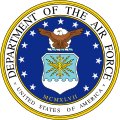Harry George Armstrong
Harry George Armstrong (February 17, 1899 – February 5, 1983) was a pioneering aerospace medicine specialist, particularly in the area of human factors in aviation. He authored the book Principles and Practice of Aviation Medicine, which is considered a classic in the field.
Early life and education[edit]
Armstrong was born in Laurel, Nebraska. He attended the University of Nebraska and received his medical degree from Creighton University in 1925.
Career[edit]
In 1926, Armstrong joined the United States Army Air Corps, where he began his career in aviation medicine. He was instrumental in establishing the Aerospace Medical Research Laboratory in Dayton, Ohio, and served as its director from 1935 to 1940.
In 1941, Armstrong was appointed as the first Surgeon General of the United States Air Force. During his tenure, he implemented many improvements in the medical care of Air Force personnel, including the establishment of the School of Aviation Medicine at Randolph Field, Texas.
Armstrong's research in the field of aviation medicine led to many significant discoveries. He developed the concept of the "Armstrong's Line," a physiological boundary above which humans cannot survive without a pressure suit. He also conducted research on the effects of high altitude on human physiology, and developed methods for preventing and treating decompression sickness.
Legacy[edit]
Armstrong's contributions to aviation medicine have had a lasting impact on the field. His book, Principles and Practice of Aviation Medicine, is still widely used as a reference in the field. The Harry G. Armstrong Award for Excellence in Aerospace Medicine is named in his honor.
References[edit]
<references />
External links[edit]
- Biography of Major General Harry G. Armstrong at the official website of the United States Air Force
Ad. Transform your life with W8MD's Budget GLP-1 injections from $75


W8MD offers a medical weight loss program to lose weight in Philadelphia. Our physician-supervised medical weight loss provides:
- Weight loss injections in NYC (generic and brand names):
- Zepbound / Mounjaro, Wegovy / Ozempic, Saxenda
- Most insurances accepted or discounted self-pay rates. We will obtain insurance prior authorizations if needed.
- Generic GLP1 weight loss injections from $75 for the starting dose.
- Also offer prescription weight loss medications including Phentermine, Qsymia, Diethylpropion, Contrave etc.
NYC weight loss doctor appointmentsNYC weight loss doctor appointments
Start your NYC weight loss journey today at our NYC medical weight loss and Philadelphia medical weight loss clinics.
- Call 718-946-5500 to lose weight in NYC or for medical weight loss in Philadelphia 215-676-2334.
- Tags:NYC medical weight loss, Philadelphia lose weight Zepbound NYC, Budget GLP1 weight loss injections, Wegovy Philadelphia, Wegovy NYC, Philadelphia medical weight loss, Brookly weight loss and Wegovy NYC
|
WikiMD's Wellness Encyclopedia |
| Let Food Be Thy Medicine Medicine Thy Food - Hippocrates |
Medical Disclaimer: WikiMD is not a substitute for professional medical advice. The information on WikiMD is provided as an information resource only, may be incorrect, outdated or misleading, and is not to be used or relied on for any diagnostic or treatment purposes. Please consult your health care provider before making any healthcare decisions or for guidance about a specific medical condition. WikiMD expressly disclaims responsibility, and shall have no liability, for any damages, loss, injury, or liability whatsoever suffered as a result of your reliance on the information contained in this site. By visiting this site you agree to the foregoing terms and conditions, which may from time to time be changed or supplemented by WikiMD. If you do not agree to the foregoing terms and conditions, you should not enter or use this site. See full disclaimer.
Credits:Most images are courtesy of Wikimedia commons, and templates, categories Wikipedia, licensed under CC BY SA or similar.
Translate this page: - East Asian
中文,
日本,
한국어,
South Asian
हिन्दी,
தமிழ்,
తెలుగు,
Urdu,
ಕನ್ನಡ,
Southeast Asian
Indonesian,
Vietnamese,
Thai,
မြန်မာဘာသာ,
বাংলা
European
español,
Deutsch,
français,
Greek,
português do Brasil,
polski,
română,
русский,
Nederlands,
norsk,
svenska,
suomi,
Italian
Middle Eastern & African
عربى,
Turkish,
Persian,
Hebrew,
Afrikaans,
isiZulu,
Kiswahili,
Other
Bulgarian,
Hungarian,
Czech,
Swedish,
മലയാളം,
मराठी,
ਪੰਜਾਬੀ,
ગુજરાતી,
Portuguese,
Ukrainian






